[ page 2 ]
... continued from page 1...
Sukhoi SU-17/ 22 "Fitter" plastic scale models in 1/72 scale: SMĚR / Mastercraft/ Pantera
modelling report
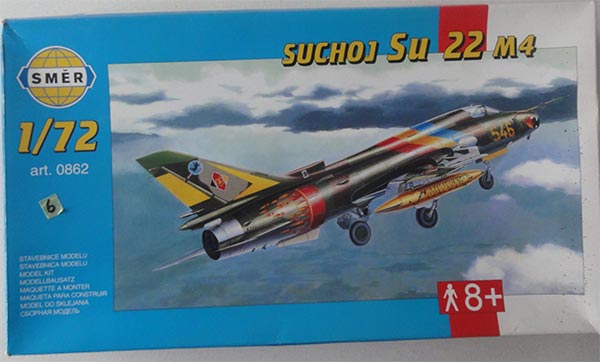
Another 1/72 kit was from SMĚR and kit #0862 for the SU-22 M4that came in 2005. It is probably an ex-Pantera mould from 1996. The kit has about 70 parts in light grey plastic. It is basic but the panel lines are recessed.
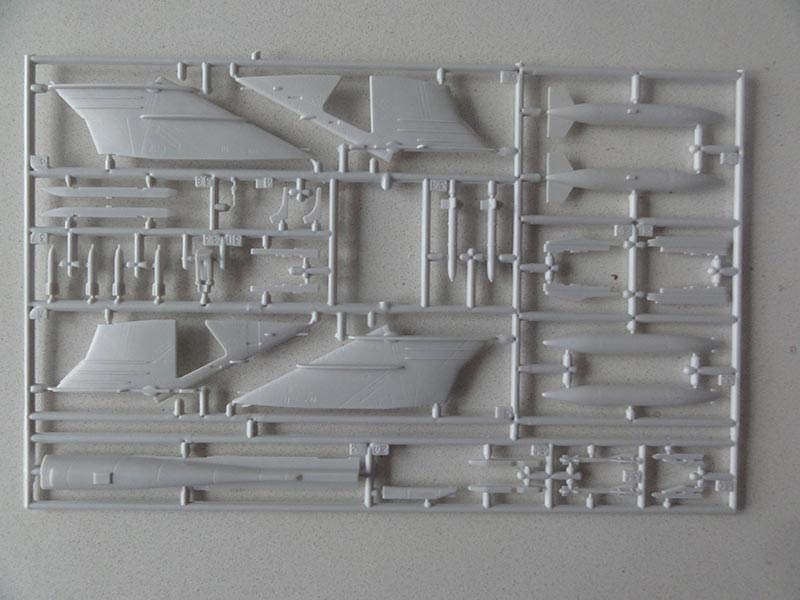
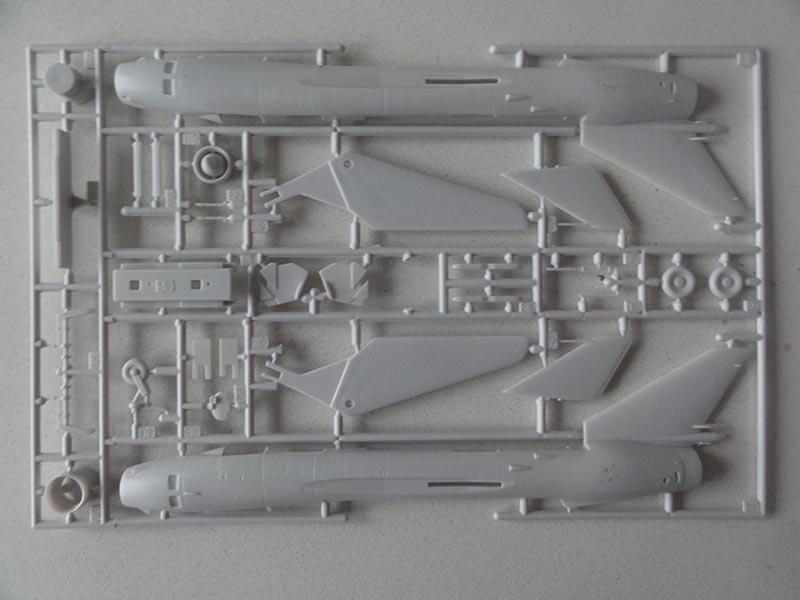
The cockpit canopy and windshield is one part (not shown). Stores are S-24, FAB-100 bombs, wing external fuel tanks and their pylons.
Nicely done is that the blow-in doors at the lower forward fuselage are suggested with indented panels. Always on real Sukhois they are seen with open slots on parked, taxiing of taking off jets.
Kit instructions present 16 build steps and the colors are indicated in Humbrol enamel paints.
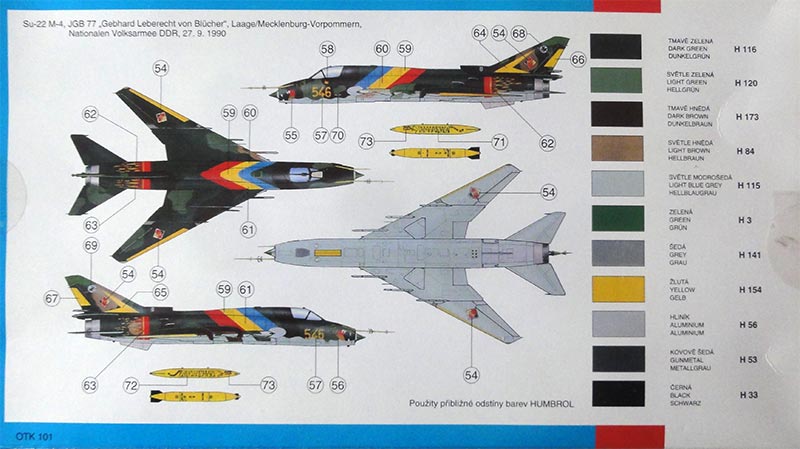
Decals are for 3 schemes:
-1- Tsjechoslovakia of no. 20 unit "Biskajsky" in a camouflage scheme;
-2- Iraq air force 1990;
-3- DDR/ East Germany air force; this special scheme is shown at the rear of the box.
You get a lot of stencilling. The decals by now are now quite old and vulnerable and tend to break apart. So use a clear decal film over them.
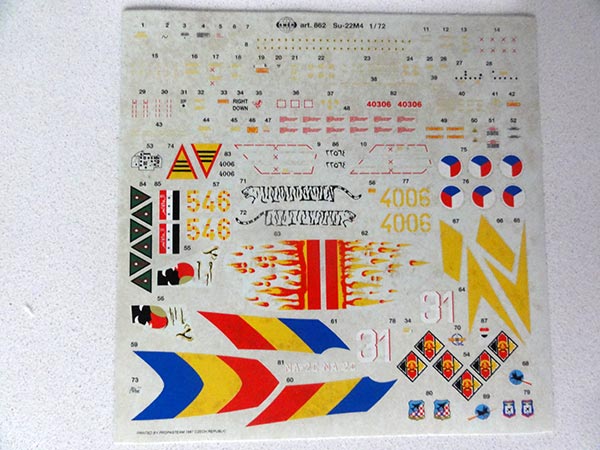

The SU-22 M4 kit was made rather straight out of box but in a different Iraqi air force scheme.
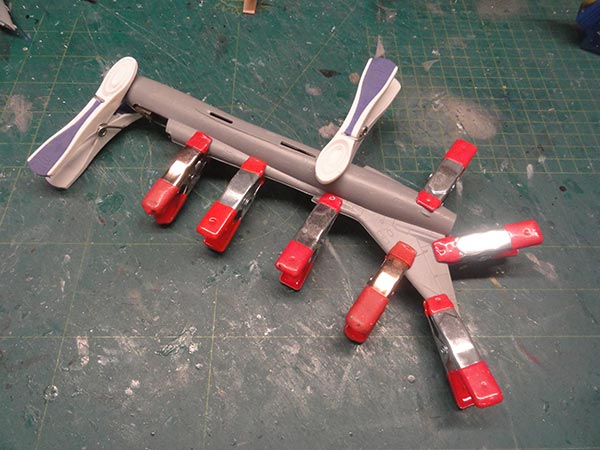
Some filling and sanding was needed also at the long spine part. The gear bays are rather basic so a few panels were inscribed inside. Note the long tail base intake fairing of the M4.
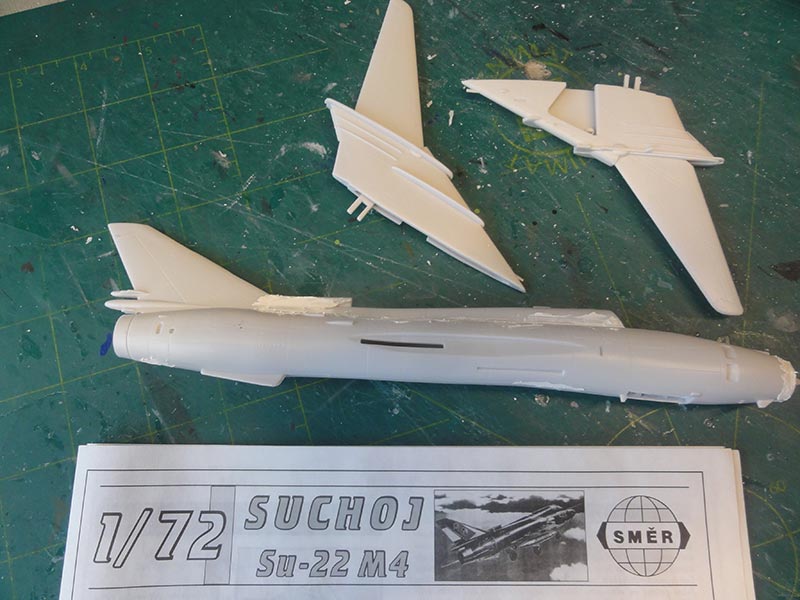
The model got a base grey primer coat. Some pre-wash black strakes were also airbrushed to get a bit variation in the applied later airbrushed paints coats. Some pylon slots were filled as some pylons would not be set.
Official colours applied to the Iraqi jet were unknown so had to interpreted from photos which is not easy. For the paint scheme a different scheme that shown in the kit instructions was airbrushed with these acrylic paints:
- lower surfaces grey about FS36375 with Gunze Sangyo Mr.Hobby H308;
- green about FS34102 with Gunze Sangyo H303;
- dark brown with Revell Aqua 84 "lederbraun".
The pattern was loosely airbrushed and it was not completely clear how it should look. An impression was used found in the book "Soviet and Russian aircraft in the Middle East", page 173.
At the wing "swivelling areas", after masking, dull aluminium was airbrused. The rear fuselage area at the exhaust was hand painted burned metal and the area near the ventral fin.
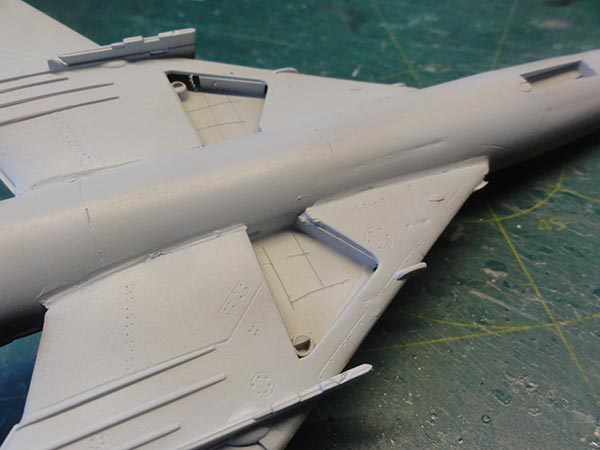
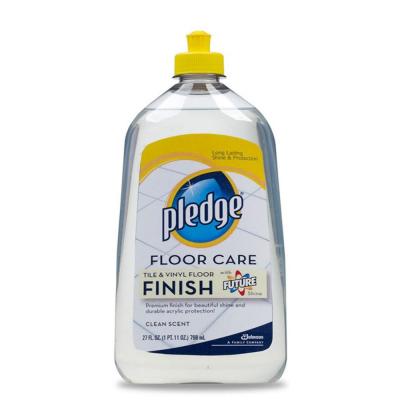
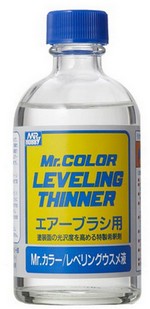
When dried an overall gloss varnish coat was airbrushed of Johnson Future/ Pledge thinned with 10% Gunze Sanyo Levelling Thinner for a better flow. This formed a good gloss surface for setting any decals.
The few Iraq markings/ decals as per kit and a few from the MASTERCRAFT kit (see below) were set.
Next, the landing gear was installed. The nose gear #19 strut in this kit is 2 millimeter too long so the lower stub was removed to get a more horizontal sit of the model.
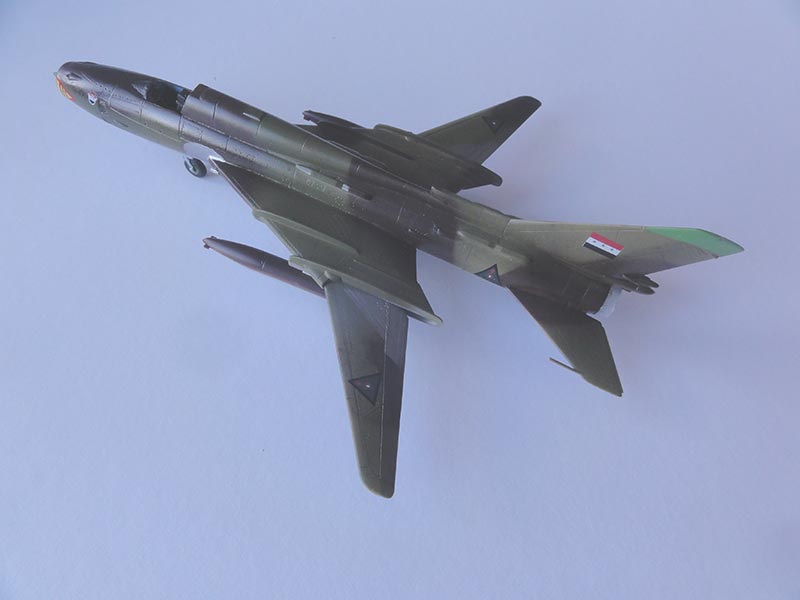
For the stores 2 MBD3 racks from the kit with FAB-100 bombs found in the Italeri kit were installed as well as 2 PTB-800 fuel tanks.
The canopy and windscreen were set closed, tiny gaps filled with white glue and painted when dried.
The few anti-collision lights and the (retracted) landing lights next to nose gear bay were painted.
The 2 plastic gun barrels were replaced with 2 metal bits of a metal needle.
The 7 static dischargers were made from bits of fishing line and set with superglue. Paint with a fine brush.
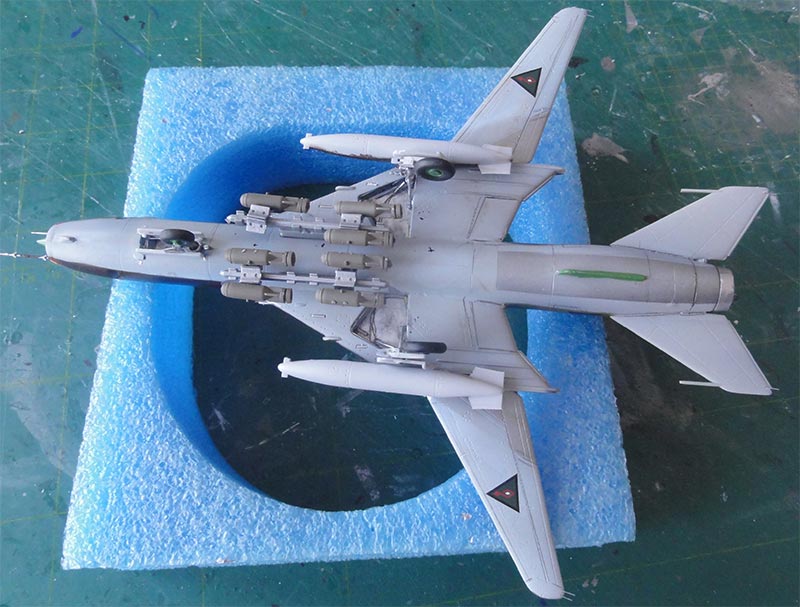
Note the lower dull aluminium area at the ventral fin. The anti-flutter weights at the stabilizers are also well visible.
For the final finish, only some slight weathering with "wash" was applied at moving surface' recesses, gears and bays with Promodeller "dark" wash, but other techniques can also be used such as very thinned varnish (Future) with a drop of black acrylic paint. The nicely done blow-in doors also got a black line at their rear to suggest the air gap.
When dried an overall semi-matt clear varnish coat was airbrushed of again Johnson Future/ Pledge with 10% X-21 "flat base" with the usual technique. Shield of the windscreen when airbrushing this clear coat.
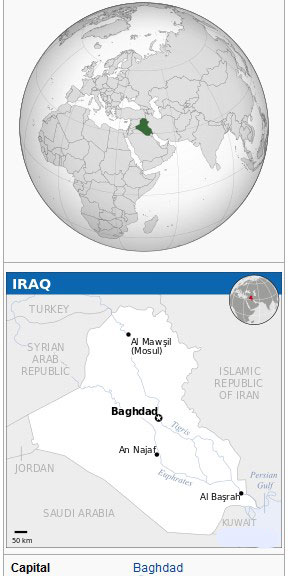



[area: 438,000 sq.km | population: 47 million | capital: Baghdad | GDP 14,000 USD per capita ]
Iraq became an independent country in 1932 with a monarchy and an air force was set up with British assistance. In 1958 a Republic was proclaimed. The air force used a mix of Western aircraft like the first Vampire jet and much later Mirage F1, Etendard and Soviet aircraft like TU-16 "Badger", several Sukhoi Fitters and MiGs. Soviet transports were also used as was a large fleet of helicopters. Early seventies some 36 SU-7BMK "Fitters" and SU-7UMK were delivered and MiG-21U trainers. In 1973 some SU-20 "Fitter-D" were provided by the Soviet Union durin the Yom Kippur War in Israel with eventually some 35 delivered and some Fitters were operational until 2003. From 1974 quite some MiG-23 were acquired from the Soviet Union, probably some 90 were delivered. In 1975 some 36 SU-22 followed, supplementing the SU-20 fleet. This included a few SU-22R fitted with the large KKR-1 reccepod and flying with No.44 and No.109 squadrons. In 1978 additional SU-22M were acquired flying with No.5 squadron near Tikrit and later No.109 squadron. In 1979 Saddam Hussein came into power.
Some 18 MiG-25 Foxbat-A fast high speed interceptors were acquired in 1980 and some more MiG-25RB followed. Through Egypt some 70 Chinese F-7B jets were obtained in 1982 and 20 FT-7B trainers. From 1984 additional 18 SU-22M3 and 36 SU-22M4 followed with some -UM trainers and the fleet was over 100 Sukhois by 1990. For ground attack from 1985 over 70 SU-25 "Frogfoot" were acquired from the Soviet Union.
There were troubles with Islamiq neighbour Iran from 1980-1988 and quite some aircraft were lost. From 1987 MiG-29 were obtained with some 31 fighters and 6 MiG-29UB trainers. From 1990 at least 24 SU-24 "Fencer" were also acquired but not yet operational at the start of the Gulf War of 1990.
Saddam with his terror dictator regime wanted more and invaded in the South their neighbour Kuwait August 1990. Another Gulf War erupted and The West responded with operation Desert Shield / Desert Storm that lasted 6 months to free Kuwait. Saddam saw big losses and ordered his air force in january 1991 to evacuate to neighbour IRAN to avoid destruction. Some 115 aircraft and their pilots fled quickly to IRAN and that included many SU-20, SU-22 and SU-24 to what was first "their enemy".
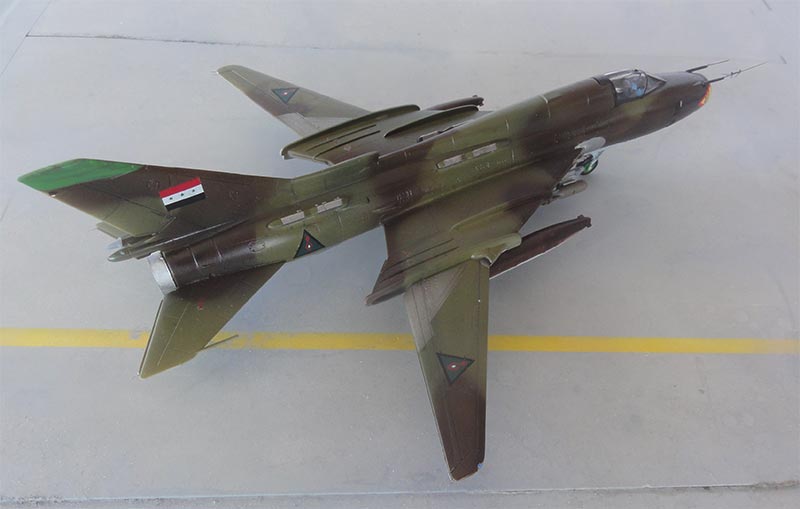
SU-22M4 as used in 1990's. IRAQ AF badge on the nose.
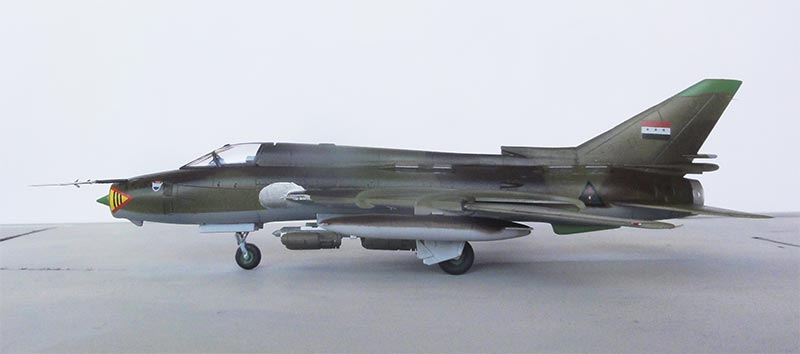
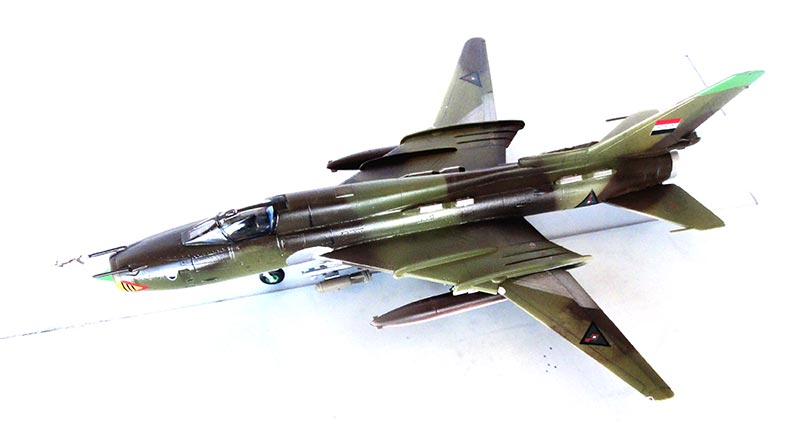
... on the desert airfield...
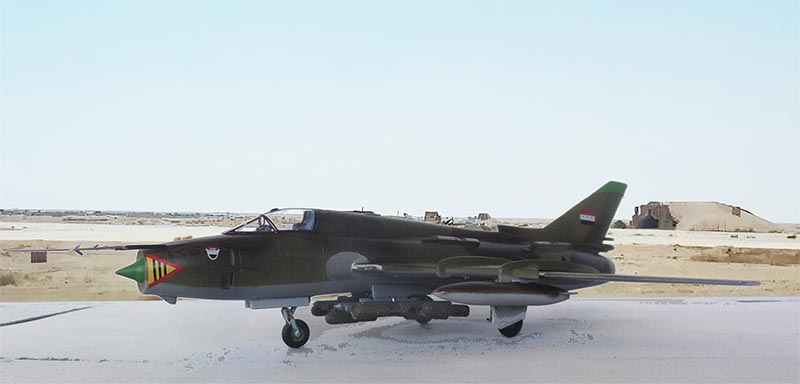
Another 1/72 SU-22 M4 "Desert Shield" kit was released by MASTERCRAFT kit #D-17 in 1997. It seems to have used the same SMER mould as described above.
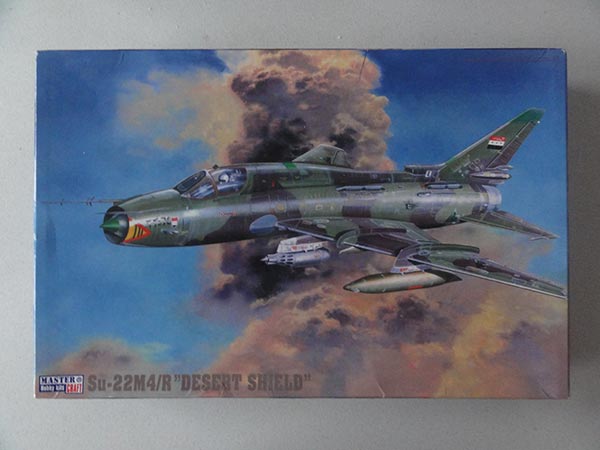
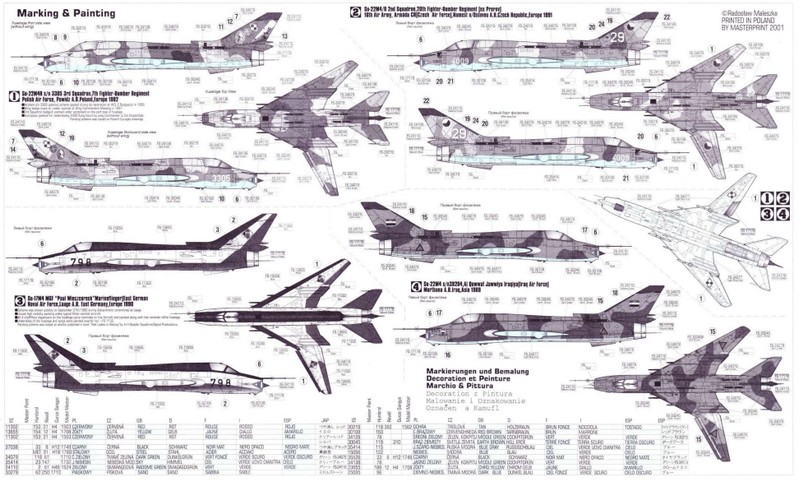
The instructions show an extensive colour paints table. I can not see if these are correct but at least they tried to guide the modeller.
In the instructions a drawing suggests a detailed K-36 ejection seat but I did not find it in my kit.
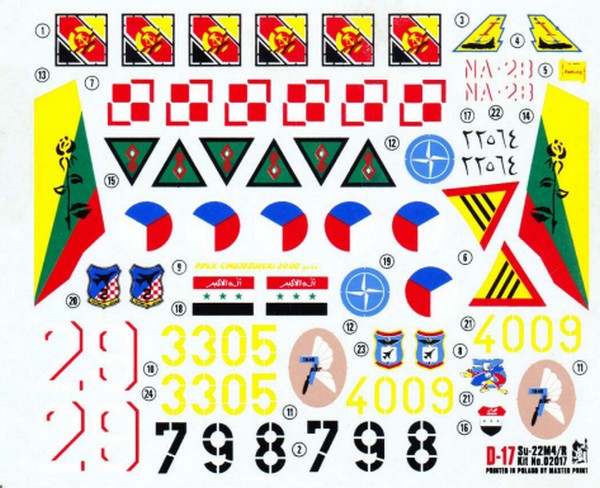
The kit decals are for:
[1] Polish air force, 7th fighter bomber group, Powidz AFB, 1992
[2] Czech air force, 20th fighter bomber regiment, 1991
[3] East German DDR , Marine Flieger, 1990 special scheme
[4] Iraq air force, 1989.
No stencilling is supplied and I feel at least the characteristic red stripes at the wing gloves should have been provided on the sheet.
The kit will be made rather straight out of the box but in another scheme.
The model was made in an IRAN air force scheme. All of these SU-22 were Iraqi aircraft that fled to IRAN during the 1991 Gulf War and had large variations in paint schemes.
I had a Begemot MiG-29 decals sheet #72-032 that also has IRAN air force roundels that seem to be the correct size for an IRAN SU-22. It was decided to make the MASTERCRAFT kit is such a scheme.
The kit parts were assembled as described earlier for the SMER kit. Some putty and sanding was needed, particularly at the long spine and the wing-fuselage joints.
Official colours applied to the jet were unknown so had to interpreted from photos which is not easy.
For the colour scheme these acrylic paints were airbrushed:
- lower surfaces Gunze Sangyo H314 (about FS35622) with a drop of blue mixed in;
- upper pattern tan Gunze Sangyo H66;
- light green mix Gunze Sangyo H319 with a few drops of yellow;
- dark green pattern Gunze Sangyo H312.
The demarcations between the colours are quite "hard" so masking was done.
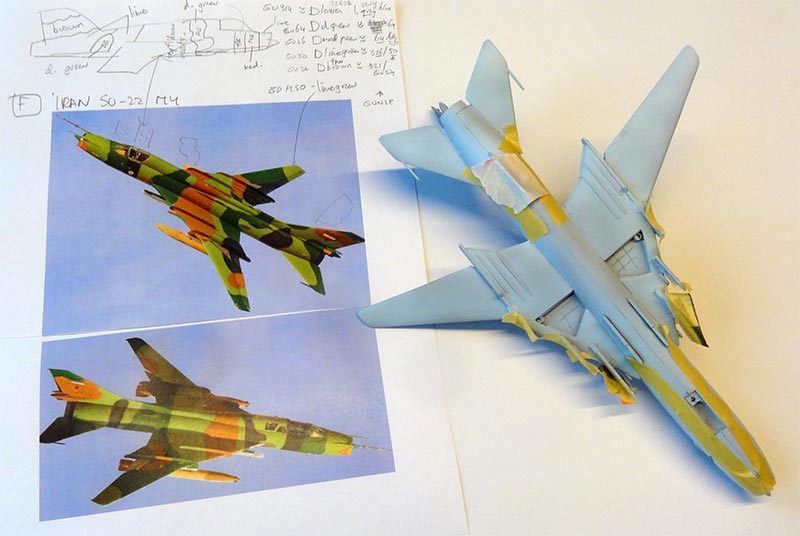
Decals as described above were set after the model got a gloss varnish with the usual technique.
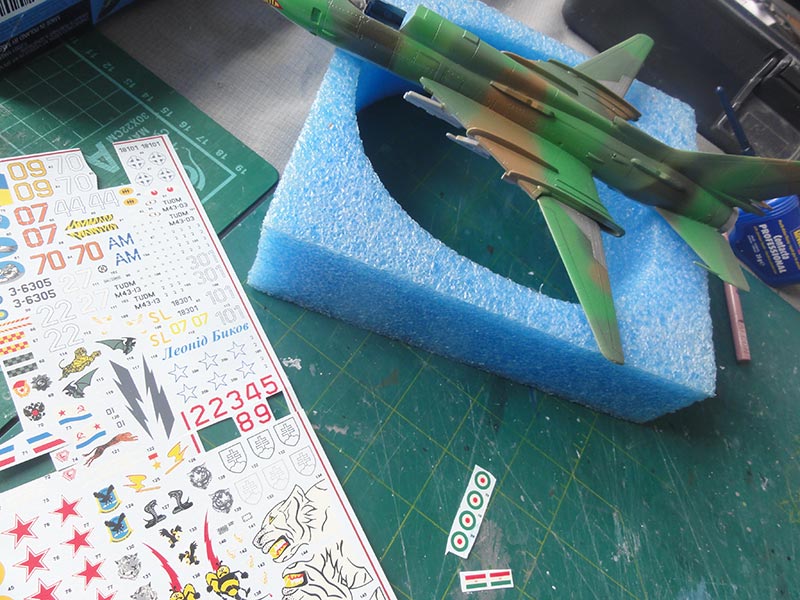
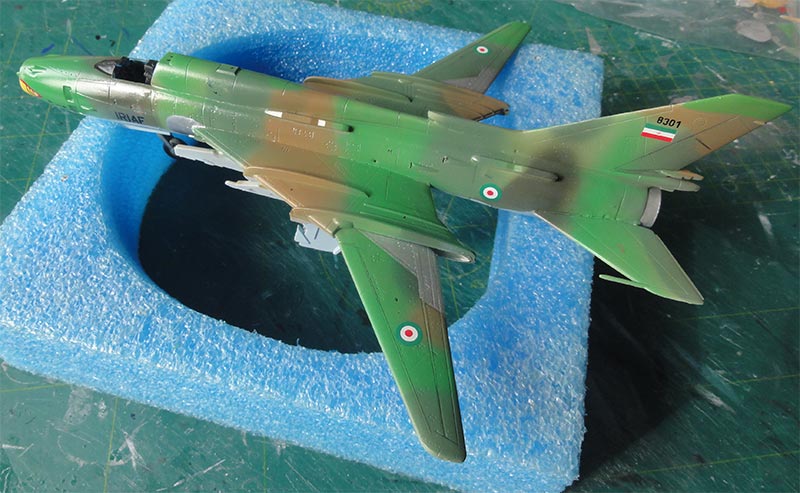
Setting the landing gear and smaller bits were done as described for the other made model. Again, the nose gear #19 strut in this kit was reduced 2 millimeter in height to get a better horizontal sit of the model.
The nicely done blow-in doors also got a black line at their rear to suggest the air gap.
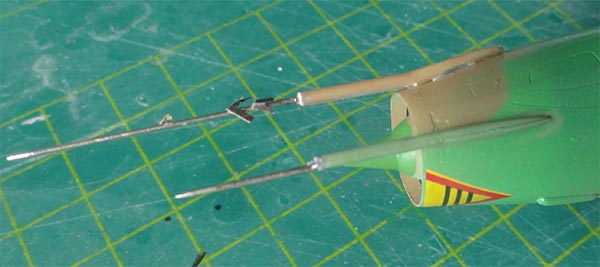
The kit pitot tubes were replaced, again made with needles and bits.
The canopy was set open and got inside a few mirrors and light blue painted frames inside.
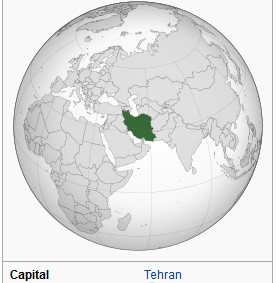
 Persian old flag
Persian old flag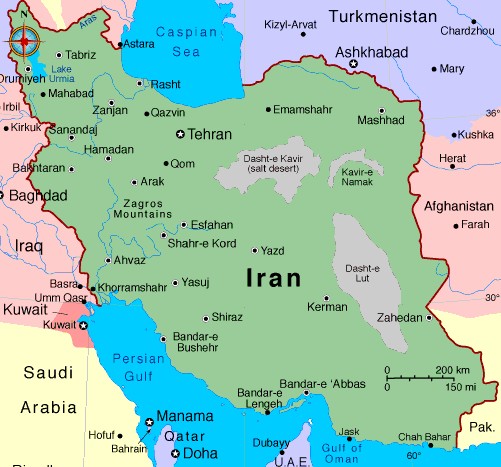
.
 ...............
...............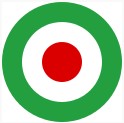 ..............
..............
[ area: 1,648,000 km2 | capital: Tehran | population: 86 million | GDP ~7,000 USD per capita nominal ]
Military
aircraft
were used in Persia (now Iran) as early as 1925. During the Shah
regime, the "Nirou Havai Shahanshaiye Iran" (Imperial Iranian Air
Force) operated
many American aircraft.
In
1979 an Islamic
revolution arised with large political and cultural changes. The
Islamic Republic of Iran Air Force was established. Due to arms
embargos it had to improvise in order to
operate the existing large aircraft fleet. Local aircraft modernization
programs were established with interesting projects like F-14 Tomcats
flying
with Hawk missiles and a few butterfly tailed F-5 aircraft. Some
24 Chinese F-6 (MiG-19 copy) were bought in 1983 and some 18 F-7N
(MiG-13 copy) in 1986 along with some FT-7 trainers.
Several
local
but drastic wars were fought with particularly Iraq from 1980-1988. About 40 additional Chinese F-7 were acquired. In 1989 some 24 Soviet MiG-29 were delivered. In 1990 some 14 SU-25 had also been acquired from the Soviet Union.
Iraqi dicator Saddam with his terror regime invaded in the South their neighbour
Kuwait August 1990 (see above...). The West responded with operation Desert Shield /
Desert Storm that lasted 6 months to free Kuwait. Saddam saw big losses
and ordered his air force in january 1991 to evacuate to neighbour IRAN to
avoid destruction. Some 115 aircraft and their pilots fled quickly to
IRAN. That included
some SU-20 and some 40 SU-22 including the SU-22M4. Some 24
Iraqi SU-24 "Fencer" were also flown to IRAN by Iraqi pilots. None
of these SU-22 were used operational by IRAN but quite some SU-24
were put into service by 1994.
For more information about the early IRAN air force look at the F-5 page here....
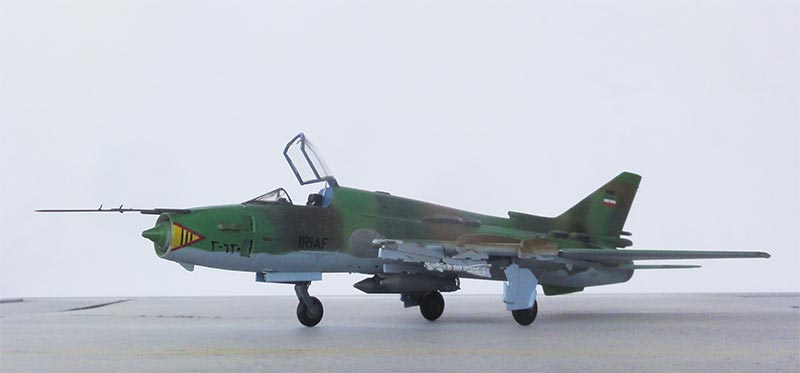
SU-22M4, ex-Iraqi unidentified jet that fled to IRAN in 1991 but never used operational by IRAN though it got some IRAN markings
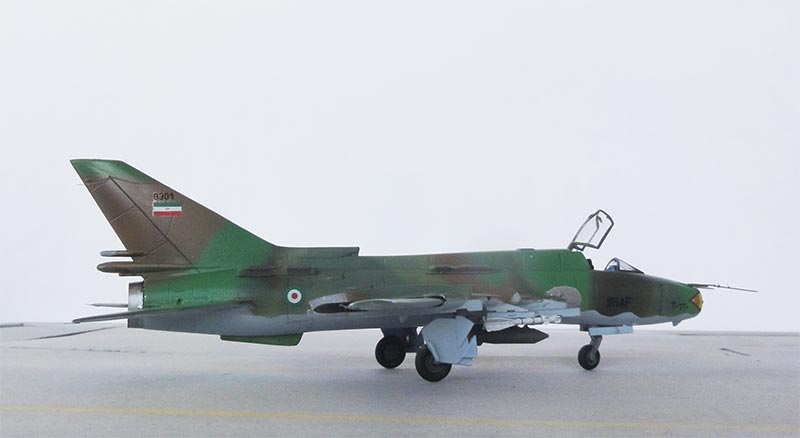
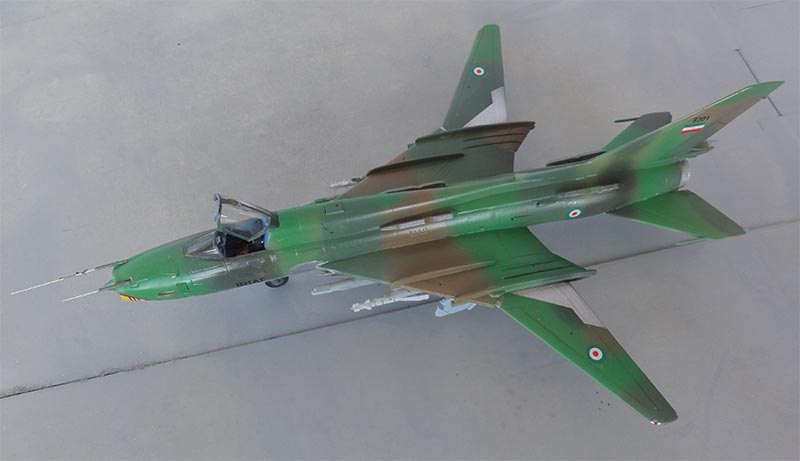
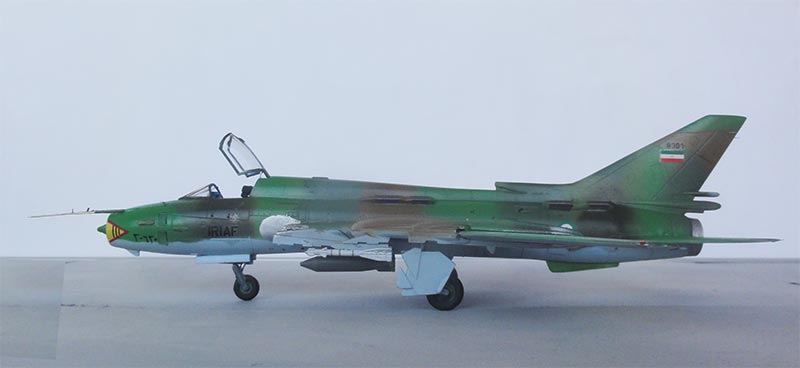
... on the platform...
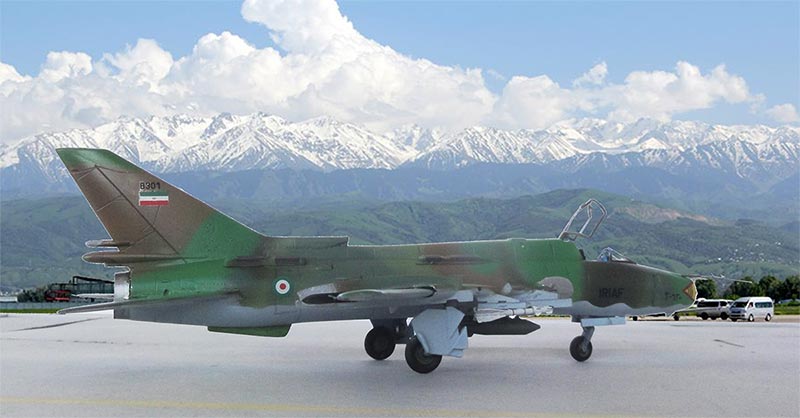
On to next [ Page 3... ]
(c) Copyright "designer"/ All rights reserved. Your comments are welcomed by webmaster
Created this page June 28, 2025